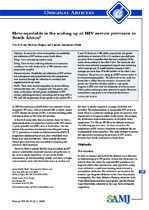| dc.contributor.author | Scott, Vera | |
| dc.contributor.author | Chopra, Mickey | |
| dc.contributor.author | Conrad, Liz | |
| dc.contributor.author | Ntuli, Antoinette | |
| dc.date.accessioned | 2010-11-24T14:06:11Z | |
| dc.date.available | 2010-11-24T14:06:11Z | |
| dc.date.issued | 2005 | |
| dc.identifier.citation | Scott, V.E., Chopra, M., Conrad, E., Ntuli, A.. (2005). How equitable is the scaling up of HIV service provision in South Africa? South African Medical Journal, 9 (2): 109-113 | en_US |
| dc.identifier.uri | http://hdl.handle.net/10566/172 | |
| dc.description.abstract | OBJECTIVES. To assess the extent of inequalities in availability
and utilisation of HIV services across South Africa.
DESIGN. Cross-sectional descriptive study.
Setting. Three districts reflecting different socio-economic
conditions, but with similar levels of HIV infection, were
purposively sampled.
Outcome measures. Availability and utilisation of HIV services
and management and support structures for programmes
were assessed through the collection of secondary data
supplemented by site visits.
RESULTS. There were marked inequalities in service delivery
between the three sites. Compared with two poorer sites,
clinics at the urban site had greater availability of HIV
services, including voluntary counselling and testing (100% v.
52% and 24% respectively), better uptake of this service (59 v.
9 and 5.5 clients per 1 000 adults respectively) and greater
distribution of condoms (15.6 v. 8.2 condoms per adult male
per year). Extra counsellors had also been employed at the
urban site in contrast to the other 2 sites. The urban site also
had far more intensive management support and monitoring,
with 1 manager per 12 health facilities compared with 1
manager per more than 90 health facilities at the other 2 sites.
CONCLUSION. The process of scaling up of HIV services seems to
be accentuating inequalities. The urban site in this study was
better able to utilise the extra resources. In contrast, the
poorer sites have thus far been unable to scale up the
response to HIV even with the availability of extra resources.
Unless policy makers pay more attention to equity, efficacious
interventions may prove to be of limited effectiveness. | en_US |
| dc.language.iso | en | en_US |
| dc.publisher | Health and Medical Publishing Group | en_US |
| dc.rights | This work is licensed under a Creative Commons Attribution - Noncommercial Works License which permits non-commercial use, distribution, and reproduction in any medium, provided the original work is properly cited. | |
| dc.subject | Equity | en_US |
| dc.subject | HIV/AIDS | en_US |
| dc.subject | Healthcare | en_US |
| dc.subject | South Africa | en_US |
| dc.title | How equitable is the scaling up of HIV service provision in South Africa? | en_US |
| dc.type | Article | en_US |
| dc.privacy.showsubmitter | false | |
| dc.status.ispeerreviewed | true | |

